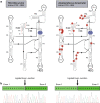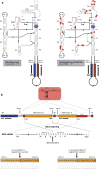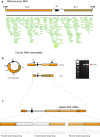Giant group I intron in a mitochondrial genome is removed by RNA back-splicing
- PMID: 31153363
- PMCID: PMC6545197
- DOI: 10.1186/s12867-019-0134-y
Giant group I intron in a mitochondrial genome is removed by RNA back-splicing
Abstract
Background: The mitochondrial genomes of mushroom corals (Corallimorpharia) are remarkable for harboring two complex group I introns; ND5-717 and COI-884. How these autocatalytic RNA elements interfere with mitochondrial RNA processing is currently not known. Here, we report experimental support for unconventional processing events of ND5-717 containing RNA.
Results: We obtained the complete mitochondrial genome sequences and corresponding mitochondrial transcriptomes of the two distantly related corallimorpharian species Ricordea yuma and Amplexidiscus fenestrafer. All mitochondrial genes were found to be expressed at the RNA-level. Both introns were perfectly removed by autocatalytic splicing, but COI-884 excision appeared more efficient than ND5-717. ND5-717 was organized into giant group I intron elements of 18.1 kb and 19.3 kb in A. fenestrafer and R. yuma, respectively. The intron harbored almost the entire mitochondrial genome embedded within the P8 peripheral segment.
Conclusion: ND5-717 was removed by group I intron splicing from a small primary transcript that contained a permutated intron-exon arrangement. The splicing pathway involved a circular exon-containing RNA intermediate, which is a hallmark of RNA back-splicing. ND5-717 represents the first reported natural group I intron that becomes excised by back-splicing from a permuted precursor RNA. Back-splicing may explain why Corallimorpharia mitochondrial genomes tolerate giant group I introns.
Keywords: Amplexidiscus; Back-splicing; Catalytic RNA; Group I intron; Intron retention; Mitochondrial RNA; Ribozyme; Ricordea.
Conflict of interest statement
The authors declare that they have no competing interests.
Figures




Similar articles
-
RNA splicing in Neurospora mitochondria. Defective splicing of mitochondrial mRNA precursors in the nuclear mutant cyt18-1.J Mol Biol. 1985 Aug 5;184(3):413-28. doi: 10.1016/0022-2836(85)90291-8. J Mol Biol. 1985. PMID: 2413216
-
Group I permuted intron-exon (PIE) sequences self-splice to produce circular exons.Nucleic Acids Res. 1992 Oct 25;20(20):5357-64. doi: 10.1093/nar/20.20.5357. Nucleic Acids Res. 1992. PMID: 1279519 Free PMC article.
-
Evolutionary and biogeographical implications of degraded LAGLIDADG endonuclease functionality and group I intron occurrence in stony corals (Scleractinia) and mushroom corals (Corallimorpharia).PLoS One. 2017 Mar 9;12(3):e0173734. doi: 10.1371/journal.pone.0173734. eCollection 2017. PLoS One. 2017. PMID: 28278261 Free PMC article.
-
Research Progress of Group II Intron Splicing Factors in Land Plant Mitochondria.Genes (Basel). 2024 Jan 28;15(2):176. doi: 10.3390/genes15020176. Genes (Basel). 2024. PMID: 38397166 Free PMC article. Review.
-
Insights into the strategies used by related group II introns to adapt successfully for the colonisation of a bacterial genome.RNA Biol. 2014;11(8):1061-71. doi: 10.4161/rna.32092. Epub 2014 Oct 31. RNA Biol. 2014. PMID: 25482895 Free PMC article. Review.
Cited by
-
Natural circularly permuted group II introns in bacteria produce RNA circles.iScience. 2021 Nov 13;24(12):103431. doi: 10.1016/j.isci.2021.103431. eCollection 2021 Dec 17. iScience. 2021. PMID: 34901790 Free PMC article.
-
The Mitogenome of the Subarctic Octocoral Alcyonium digitatum Reveals a Putative tRNAPro Gene Nested within MutS.Curr Issues Mol Biol. 2024 Jul 27;46(8):8104-8110. doi: 10.3390/cimb46080479. Curr Issues Mol Biol. 2024. PMID: 39194696 Free PMC article.
-
Organellar Introns in Fungi, Algae, and Plants.Cells. 2021 Aug 6;10(8):2001. doi: 10.3390/cells10082001. Cells. 2021. PMID: 34440770 Free PMC article. Review.
-
Structural basis of circularly permuted group II intron self-splicing.Nat Struct Mol Biol. 2025 Jun;32(6):1091-1100. doi: 10.1038/s41594-025-01484-x. Epub 2025 Jan 31. Nat Struct Mol Biol. 2025. PMID: 39890981
-
Revealing the high variability on nonconserved core and mobile elements of Austropuccinia psidii and other rust mitochondrial genomes.PLoS One. 2021 Mar 11;16(3):e0248054. doi: 10.1371/journal.pone.0248054. eCollection 2021. PLoS One. 2021. PMID: 33705433 Free PMC article.
References
Publication types
MeSH terms
Substances
LinkOut - more resources
Full Text Sources
Other Literature Sources

